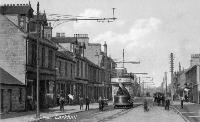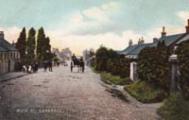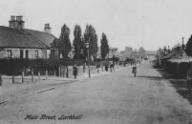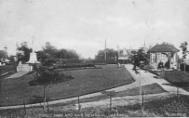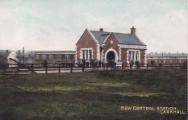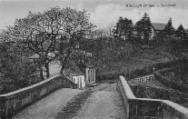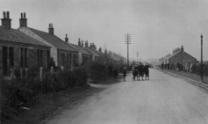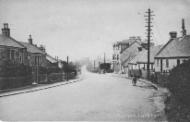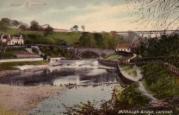Dalserf Parish
Information specific to this area can be found below and on the left
menu bar. We also recommend consulting the many general pages for
information of general relevance to miners' lives.
Please also see the following pages for information of direct relevance to this area:
Above L to R - Union Street, Larkhall, 2 views of Muir Street, Larkhall (Right c1912), Below L to R - Larkhall Public Park & War memorial, New Central Station Larkhall, Millheugh Bridge c1925
Above L to R Burnhead Larkhall, Machan, Millheugh Bridge C 1911, Below L to R Trinity Church, Union St Larkhall
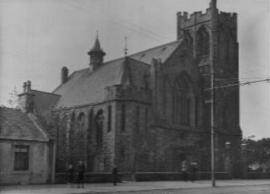
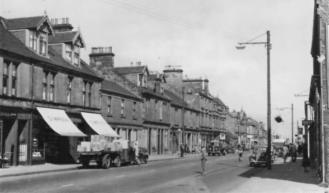
Ordnance Gazetteer of Scotland, Francis H Groome, 1895
Dalserf, a Clydesdale village and parish in the Middle Ward of Lanarkshire. The village, standing on the left bank of the Clyde, 1 mile E of Ayr-Road station on the Caledonian railway, 3 miles ESE of Larkhall, and 7 SE of Hamilton, was formerly a place of some size and importance, but has long been going steadily into decay, and now consists of only a few low-roofed cottages, situated among gardens.
The parish, which also contains the villages of Millheugh and Rosebank, and most of the town of Larkhall, formed anciently the chapelry of Machan under Cadzow or Hamilton, itself being known as Machanshire. It was for many ages the property of the crown. The powerful family of the Comyns at one period had possession of it, but furing the contested reign of John Baliol it again became part of the royal demesnes, and continued as such till the year 1312, when King Robert Bruce made a grant of it to Walter, the son of Gilbert, the ancestor of the Duke of Hamilton It was afterwards divided among junior branches of the Hamilton family, and, probably about the era of the Reformation, was constituted a parish, taking name from Dalserf village. It is bounded NW by Hamilton, NE by Cambusnethan and Carluke, SE by Lesmahagow, and SW by Stonehouse. Kite-shaped in outline, it has an utmost length from N by W to S by E of 5 3/8 miles, an utmost breadth from E to W of 3 1/2 miles, and an area of 7035 3/4 acres, of which 79 1/2 are water. The Clyde winds 4 3/8 miles north-westward along all the Carluke and Cambusnethan border; Cander Water 2 1/4 miles north-north-westward to the Avon along the Stonehouse border; and Avon Water itself 3 1/8 miles, also north-north-westward along the Stonehouse and Hamilton border. Where the Clyde quits the parish, opposite Lower Carbarn, the surface sinks to less than 100 feet above sea-level, thence rising to 345 feet beyond Larkhall, 477 at Strutherhill, 576 at Canderdikehead, and 623 at Cander Moss, in the southern corner of the parish, whose interior forms a sort of plateau between the Clyde and the Avon.
The rocks are chiefly of the Carboniferous formation. Coal abounds, and is extensively mined at Ashgill, Broomhill, Canderside, Cornsilloch, Skellyton, etc ; ironstone is known to be plentiful; and sandstone, of quality to furnish excellent building blocks, is largely quarried. The soil, along the Clyde, is rich alluvium; on the banks rising steeply from the Clyde, is of various quality; and, on the higher grounds, is mostly strong heavy clay. All the land, except a small patch or two of moss, is either regularly or occasionally cultivated. The tract adjacent to the Clyde lies almost in the heart of the luxuriant range of the Clydesdale orchards, and was famed for its fruit from very early times; but, owing to frequent failure of crops and increasing importation of fruit from England, Ireland, and foreign countries, has ceased to be exclusively devoted to orchard purposes. The dairy, on the other hand, for butter, cheese, and fatted calves, has much attention paid to it. The Rev. John Macmillan, founder of the Reformed Presbyterians in 1743, lived for some time near Millheugh, and lies in Dalserf churchyard; and the Rev. James Hog, one of the twelve vindicators of the famous Marrow of Modern Divinity (1721), was parish minister. The principal mansions are Broomhill, Dalserf House, which is finely situated to the west of the village, and Millburn House; and much of the property is divided between the Hamiltons of Raploch and the Hamiltons of Dalserf. In the presbytery of Hamilton and synod of Glasgow and Ayr, this parish is divided into the quoad sacra parishes of Larkhall and Dalserf, the latter being worth £326. The church, at the village, was built in 1655, and contains 500 sittings. Two public schools, Dalserf and Shawsburn, with respective accommodation for 201 and 300 children, had (1891) an average attendance of 182 and 245 day and 37 evening scholars, and grants amounting to £195 5s. and £244 1s and £18 9s. Pop. (1801) 1660, (1831) 2680, (1861) 4876, (1871) 7341, (1881) 9376, (1891) 11,325, of whom 2965 were in Dalserf quoad sacra parish.—Ord. Sur., sh. 23, 1865.
Larkhall, a Lanarkshire town and quoad sacra parish, chiefly in Dalserf parish, but partly in Hamilton. Standing 320 feet above sea-level, 1/4 mile from the right bank of the Avon, 1 1/2 from the left bank of the Clyde, and 3 1/2 miles SSE of Hamilton, the town has a station on the Lesmahagow branch of the Caledonian railway, 6 1/4 miles S by E of Holytown. With slight exception it began to be built about 1776, and for 15 or 20 years continued to be only a small village. It then was rapidly extended, chiefly by means of building societies, but is less a town, in the ordinary sense of the word, than an assemblage of villages, hamlets, rows of houses, and isolated dwellings. Its inhabitants are principally miners connected with neighbouring collieries, bleachers, and handloom weavers in the employment of Glasgow manufacturers. A drainage scheme for the district was carried out by the County Council in 1893-1894 at an expense of £3500. Larkhall has a post office, with money order, savings' bank, and telegraph departments, a branch of the Union Bank, a gaswork, a quoad sacra parish church (1835) renovated and extended in 1889, a Free church, a U.P. church (1836), an Evangelical Union chapel (1876), St Mary's Roman Catholic church (1872), a public library, baths, public halls, a bowling club, cemetery, etc. The quoad sacra parish is in the presbytery of Hamilton and synod of Glasgow and Ayr; its minister's stipend is £275. Four public schools - Academy, Duke Street, Glengowan, and Muir Street - and a Roman Catholic school, with respective accommodation for 448, 260, 350, 350, and 212 children, had (1892) an average attendance of 2432, 217, 219, 343, and 123, and grants of £474 17s 6d.., £217, 8s. 6d., £309, 17s. 7d., £384 7s. 8d., and £116, 8s. Pop. of town (1861) 2685, (1871) 4971, (1881) 6503, (1891) 8349 of whom 88 were in Hamilton; of q. s. parish (1871) 5332, (1881) 7063, (1891) 8845 of whom 485 were in Hamilton.—Ord. Sur., sh. 23, 1865.
Broomhill, an estate, with a mansion, in the W of Dalserf parish, Lanarkshire, 1 mile SSW of Larkhall. It came into possession of John Hamilton, son of James, first Lord Hamilton, in 1473, and with his descendants it has since continued, its present owner being Wm. Hy. M'Neill Hamilton of Raploch. The original residence was a bartizaned fortalice, 4 stories high, and only 1 room wide; bore the name of Auld Machan Castle; and was burned about 1570 by Sir William Drury, governor of Berwick, but afterwards repaired. An old Romish chapel stood near it, in a field still called Chapel-Rome; was menaced with destruction by a mob in 1563; was saved from their fury by the Lady Hamilton of the period assuring them that she intended to convert it into a barn; and stood till 1724, when it fell to the ground under its own weight. Excellent sandstone for building is quarried on the estate.
Cander, a rivulet of Lanarkshire. It rises in Lesmahagow parish; runs about 3 miles northward to the meeting-point with Stonehouse and Dalserf parishes; and goes 2 1/4 miles further NNW, along the boundary between these parishes, to the river Avon, at a point 9 furlongs NNE of Stonehouse village. The section of Dalserf parish adjacent to it is called Cander district; and a portion of that district, containing workable coal, bears the name of Canderside.—Ord. Sur., sh. 23, 1865.
Millburn House, a mansion in Dalserf parish, Lanarkshire, immediately S of Dalserf village.
Netherburn, a village in Dalserf parish, Lanarkshire, with a station on the Lesmahagow railway, 3 3/4 miles SSE of Larkhall. It has a post-office. Pop. (1881) 347, (1891) 386
Rosebank, a village in Dalserf parish, Lanarkshire, on the left bank of the river Clyde, nearly opposite Mauldslie Castle, 3 1/4 miles SE of Larkhall.
A topographical dictionary of Scotland Samuel Lewis, 1846
Dalserf, a parish, in the Middle ward of the county of Lanark ; including the villages of Millheugh, Larkhall, and Rosebank, and containing 3205 inhabitants, of whom 112 are in the village of Dalserf, 7 miles (S. E. by E.) from Hamilton. This place is supposed to derive its name from the Gaelic words Dal, signifying "a holm" or "flat field," and Sarf, " a serpent," making together the term " the field of serpents." The parish was anciently tailed Machanshire, but assumed the name of Dalserf, as is generally thought, about the time of the Reformation, through the removal of the church from its former site, at Chapelburn, to the locality of the village of Dalserf. It was originally an appendage and chapelry of Cadzow, now Hamilton, parish, and was during a long period the property of the crown. The celebrated family of the Comyns had for some time possession of it; but it reverted to the crown in the reign of Baliol, and in 1312 Robert Bruce made a grant of it to Sir Walter, son of Gilbert, ancestor of the Hamilton family, who have retained the principal estates in the parish to the present time. In the 14th century the district was made a barony, called the barony of Machane or Machanshire. The Hamiltons prominently appear in Scottish history ; they warmly espoused the cause of Mary, Queen of Scots, and several of them were engaged in her wars, and afterwards suffered severely for the part they had taken in them.
The parish is six and a half miles in extreme length, and varies in breadth from two miles to four and a half, containing 7219 acres; it is bounded on the east and north-east by the river Clyde, and on the west and south-west by the Avon and Gander. The surface in the centre of the parish is tolerably level; but on the east towards the Clyde, and on the west towards the Avon, the fall is considerable, and in many places somewhat abrupt. The slope towards the north is continuous, and far more gradual than those on the eastern and western sides. The view on the north and northwest is terminated by the Campsie hills and the mountains of Dumbarton and Argyllshire; the view on the south is bounded by Tinto, of which, with its circumjacent scenery, a very fine prospect may be had from the high lands in this parish. Large quantities of pheasants and woodcocks, and some blackcocks, are seen here; and at the close of autumn, many flocks of plovers from the moorlands visit the wheat-fields. The chief rivers are the Clyde and Avon ; the Cander, which is the next in size, falls into the Avon, and gives the name of the district of Cander to that part of the parish inclosed by it, where there are some superior farms. Numerous burns rise in the parish, and breaking forth from the high ridge on the western side of the river Clyde, dash in many places with great impetuosity over the abrupt sandstone rocks, forming several beautiful cascades. After this they run on till they fall into the Clyde. The ravines formed by these waterfalls, which are swollen in some parts of the year and frequently dry in others, are clothed with foliage, and stretching across the country obliquely to the two great rivers, diversify the scenery, and add considerably to the striking views on the Clyde. The river Avon, also, has clusters of verdant knolls and many clumps of rich plantation on its precipitous sides. The chief streams contain salmon, trout, salmon-fry, and par, which, however, bear at present no proportion to their former numbers, owing to the machinery erected on the banks, from which the residuum of chemical and dyeing operations runs into the waters ; the drainage of lime manure from contiguous lands ; and the passage of steam-vessels.
The soil varies considerably throughout the parish. The low ground in the neighbourhood of the rivers is mostly rich alluvial deposit, consisting chiefly of sand and mud of great depth, resting upon a subsoil of sand and gravel. In the higher lands near the Glasgow and Carlisle road, and by the village of Dalserf, which stands about 120 feet above the level of the sea, the soil is a strong heavy clay, lying upon a compact tenacious subsoil of till. In some places are strips of sandy earth ; and in others, especially near the Avon, the grounds are chiefly loam. The southern part contains a few acres of moss; but, with this exception, the whole parish is cultivated. The chief crops are wheat and oats, the soil in general not being considered suited to green crops, though in some parts very good potatoes, turnips, carrots, and beet-root are produced. The farmers pay great attention to dairy-farming ; the cows are chiefly of the Ayrshire breed, and about 500 are kept. Much competition exists in the improvement of every description of livestock, for which premiums have been awarded to some of the farmers by the Highland and Agricultural Society of Scotland. The cultivation of orchards also forms an important part of the rural occupations, the parish being situated in about the centre of the great range of fruit plantations in Clydesdale. A few acres of fruit-trees are cultivated on the banks of the Avon ; but the chief plantations are near the Clyde, among the acclivities overlooking the river, which are too abrupt and rugged to admit the approach of the plough. Apples, pears, and plums of every kind grow luxuriantly, the plum range, however, only extending a distance of three or four miles along the river. The rateable annual value of the parish is £7704:. The rocks consist of sandstone and freestone, of the latter of which several excellent quarries are wrought. Large quantities of coal, also, are obtained in every direction, the district forming a part of the great coal basin stretching from near Glasgow in the north, for a distance of about thirty miles, to the water of Douglas in the south. The produce of the collieries, some years ago, was about 16,000 tons annually ; but it is now much more considerable.
The chief mansions are, Dalserf, Millburn, and Broomhill, all of which are respectable structures, standing in the midst of beautiful scenery. The villages are considerable, and together contain about two-thirds of the population of the parish. Some of the inhabitants are engaged in the manufacture of cotton, the weaving of which is superintended by agents employed by Glasgow firms ; and many females are occupied in the manufacture of lace, for the houses at Hamilton. Among the roads that intersect the parish are, one from Glasgow to Carlisle, another from Glasgow to Lanark, and a third from Edinburgh to Ayr, which crosses the river Clyde at Garion Bridge. The ecclesiastical affairs are subject to the presbytery of Hamilton and synod of Glasgow and Ayr. There is an old manse, with a glebe worth £37. 10s. per annum ; the stipend is £264 12s., and the Duke of Hamilton is patron. The church, which is beautifully though somewhat inconveniently situated on the bank of the Clyde, was built in 1655, and repaired in 1721 ; it contains 550 sittings. There are two parochial schools, one of which is in the village of Dalserf, and the other at Larkhall ; the classics, mathematics, French, with all the usual branches of education, are taught, and the master of the Dalserf school has a salary of £34, with a house and garden. A good subscription library has been established at Larkhall, and another at Dalserf with 120 volumes. The chief relics of antiquity are two tumuli, in one of which, situated at Dalpatrick, some workmen a few years ago found a stone coffin, about two feet and a half long, and a foot and a half wide, in which was deposited an urn containing a human jaw with the teeth, and other bones. Another urn was also found, of very superior materials and construction, near which was a lamp of baked clay. The remains of mounds with fortifications, and cairns, may still be faintly traced ; and some years ago an earthen pot was dug up at Millheugh, containing coins of Elizabeth, James I., and Charles I. There are several chalybeate springs in the parish, and one or two impregnated with sulphur.
Larkhall, lately a quoad sacra district, in the parishes of Dalserf and Hamilton, Middle ward of the county of Lanark; containing, with the village of Millheugh, 2453 inhabitants, of whom 1609 are in the village of Larkhall, 3 1/2 miles (S. E.) from Hamilton. The district comprised the lands of Broomhill, West Machan, and Meadowhill; a portion of Dalserf lying between those lands and the river Avon ; and considerable strips of the parish of Hamilton to the north and west. The village of Larkhall, which is situated in the Dalserf portion of the district, and on the great road from Glasgow to Carlisle, is of modern erection, built on a regular plan, and has latterly very much extended, and increased in population. It is now the largest village in Dalserf parish, and mostly inhabited by weavers. In its vicinity are several hamlets, rows of houses, and other dwellings, the whole so approximating with it as to be considered parts of one town. Within the last ten years a post-office, subordinate to Hamilton and Glasgow, has been established ; and other facilities are fast tending to the improvement and importance of the place. A small fair, once accompanied by a horse-race, is held here in the month of June. The river Clyde flows at a distance of two miles north-eastward. The ecclesiastical affairs are directed by the presbytery of Hamilton and synod of Glasgow and Ayr, and the patronage is vested in the male communicants : the stipend of the minister is £80, derived from seat-rents. The church, built by subscription, aided by the General Assembly's extension fund, was opened for divine service in January, 1836, and contains 720 sittings, of which thirty are free. There is a place of worship for the Relief, very recently enlarged j also a parochial school, in which, besides the usual branches of education, Latin is taught: the master has an annual salary of £5, with a house, schoolroom and garden, and the fees. A library, instituted in the year 1809, contains upwards of 500 volumes.
Millheugh, a village, in that portion of the parish of Dalserf which formed part of the late quoad sacra parish of Larkhall, Middle ward of the county of Lanark, 1 mile (W. by S.) from Larkhall; containing 384 inhabitants. This village is situated in the north-western part of the parish, and in a narrow valley on the banks of the river Avon, through which passes the road from Glasgow to Carlisle. It is a place of some antiquity, and formerly had a distillery, a brewery, and some factories, all of which have disappeared ; its population, however, is engaged in various other branches of industry, and a bleachfield has recently been established, affording employment to a considerable number of hands. The village of Rosebank nearly adjoins Millheugh.
